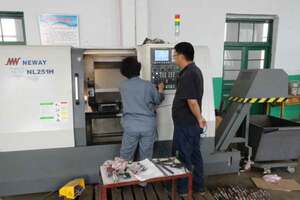الجسم
What is aluminum machining? Characteristics and techniques
Thanks to its characteristics, aluminum is one of the most used materials in industry and, specifically, machining aluminum is much more profitable and productive to obtain parts.
In this post, we are going to explain in greater detail what aluminum machining is, what its characteristics are, and what basic considerations must be taken into account when choosing the right tools.
Aluminum machining: what is it
Machining is the process for manufacturing parts by removing excess material, which can be by chip removal or abrasion. In this case, aluminum machining uses said material as its raw material for the production of parts through this method.
For its part, aluminum is a very malleable, low-density material that allows it to be worked easily and at high speeds. For this reason, the naval, aerospace, automotive, railway, or construction sectors, among others, use aluminum parts cnc machining on a recurring basis.
But aluminum does not exist in a single composition. Actually, there are more than a thousand different possible alloys, which are achieved by adding one or more additional elements to pure aluminum, in order to further improve its characteristics.
Thus, to choose the specific aluminum alloy for the manufacture of parts, various factors come into play, such as: its resistance to corrosion, hardness, price, weight and even its appearance.
That said, as an example, these are some of the alloys used in industry for machining processes:
- Aluminum 6061. One of the most used for its great versatility and low cost. It is commonly used to make automotive or aviation components, among others.
- Aluminum 5083. With great resistance to corrosion and very suitable for welding, it is very common for its application in the nautical sector.
- Aluminum 7075. It offers high thermal resistance and hardness, although it is one of the most expensive aluminums. But it is usually used for the manufacture of parts that are going to be subjected to great fatigue.
Characteristics of aluminum for machining
In general, this material is characterized by being very deformable and having a low density, as well as being resistant to corrosion and a good thermal and electrical conductor. In addition, depending on its alloy, it can achieve great hardness and can even be recycled and reused without losing its properties.
These favorable technical aspects are combined with the fact that it is an abundant material, and whose price is quite affordable, so it is understandable why it has become one of the star materials for the industry.
On the other hand, during the machining process, the machines exert less laser cutting force. Thus, this material consumes much less energy during its production, compared to other materials such as steel, but it goes faster, increasing productivity and efficiency without losing cutting precision.
Specifically, the force required for the aluminum extrusion and machining process is around 30% of the force needed during steel machining. However, the friction of aluminum with the cutting pieces is higher, compared to that suffered by other materials.
This increased friction could lead to dullness, causing deterioration of the machined aluminum surface, if it is subjected to low speeds or high speeds with inadequate cooling.
Dulling has to do with the accumulation of material that forms on the cutting surface, above the cutting edge, and that can cause problems in machining, leading to unwanted shapes, poor finishes and incorrect dimensions.
But this problem can be adequately solved by using a coolant, increasing the hardness of the aluminum alloy or even adjusting the cutting speed.
Machining process of aluminum parts
To obtain the best results with the metal forging and machining of aluminum, it is necessary to know this material well, in order to know how to apply the appropriate tools and techniques.
Thus, for example, it is convenient to know in advance what the aluminum alloy to be applied in the manufacture of the piece will be. This will protect the tools and all necessary measures can be indicated during machining.
For its part, aluminum cnc turning can be done by chip removal, through a CNC machining center or lathe, or by electrosion or laser cutting. Focusing on chip removal, aluminum machining supports any process.
Both milling, turning, drilling or saw cutting can be used to create cnc milling aluminum parts, as long as a series of specific parameters are established for each case.
Aluminum Machining Tools: Considerations
When choosing a tool for swiss machining aluminum, there are a number of aspects that must be considered that will be key to obtaining the best results.
In this case, the weathering steel metal needs to be sharpened well, and its rake angle is larger than that used for steel processing, and consideration is given to properly draining excess material to avoid clogging and throwing lost parts, as well as damage to the machine.
On the other hand, despite its good thermal conductivity, it is appropriate to use a coolant, which will further improve cutting conditions and help to evacuate shed material and avoid clogging.
Likewise, tools that are as durable, powerful and durable as possible must be used; and materials such as hard metals, high-speed steel and diamond must be given preference as they can adequately resist cutting from aluminium.
- heavy metal. It consists of a mixture of cobalt and tungsten, which makes the tool last longer. Its use is suitable for processing aluminum die casting containing a large amount of silicon, and it is suitable for high-speed processing.
- Fast steel. They are hard and wear-resistant steels with high performance due to their alloying with other materials such as chromium, cobalt or tungsten. Likewise, they are the best choice for machining aluminum that is low in silicon in the alloy.
- Diamond. Diamond tools stand out for their long service life, and their use in short-chipping aluminum machining is also prominent.
- That said, any machine used to machine aluminum will work as long as the minimum recommended cutting speed for each specific alloy is achieved and it does not vibrate at high speeds.
In the end, given the capabilities of the rotating shaft and the chip evacuation capabilities already mentioned, it is wisest to choose rigid machinery with strong bearings.
Professional aluminum Cnc Machining
Aluminum 5 axis machining tasks must be handled by qualified and trained professionals to handle the machinery and tools required for the process.
At Pintejin, we are experts in machining, we have state-of-the-art automated machinery, equipped with CNC machining(Español: mecanizado cnc) centers and lathes, as well as the necessary technology to achieve the highest precision and speed in machining.
Please contact us if you need assistance with the design and manufacture of aluminum parts. For this, you can write to us at info@pintejin.com. You will get all the advice you need!
This article comes from: What is aluminum machining? Characteristics and techniques













تعليقات